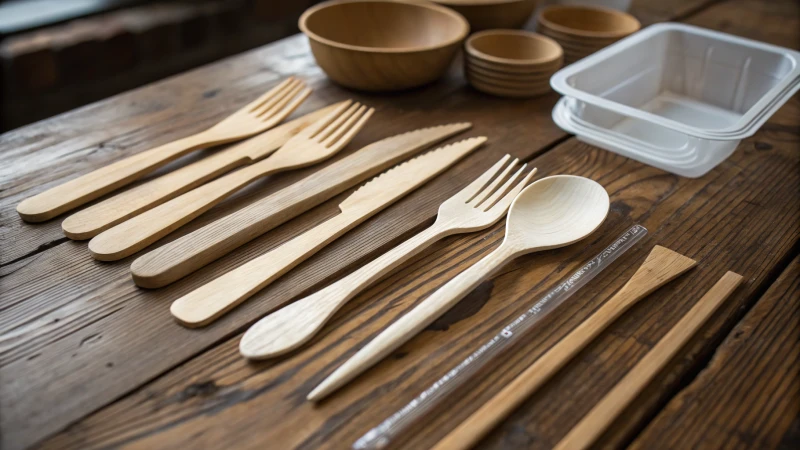
Choosing the right cutlery for your business is more than just about cost—it's about values, aesthetics, and impact.
While disposable wooden cutlery might be pricier than plastic initially and cheaper than metal, its environmental advantages and visual appeal often justify the investment, especially for eco-conscious businesses.
When I first ventured into sustainable choices for my business, I was overwhelmed by the options. But then, I stumbled upon disposable wooden cutlery, and it was like finding a hidden gem. Yes, it can cost more than plastic upfront, but every time I see the positive reactions from my customers, I know it’s worth it. Not only does it align with our green values, but it also elevates our brand image.
Think about the long-term gains: reducing your carbon footprint and appealing to a growing base of eco-conscious consumers. It's not just about the immediate financial outlay; it's an investment in your brand's future and the planet's health. For me, that makes all the difference. So let’s dig deeper into how these factors play out in real-world scenarios.
Wooden cutlery is cheaper than metal cutlery.True
Wooden cutlery generally costs less upfront compared to metal alternatives.
Plastic cutlery is more eco-friendly than wooden cutlery.False
Plastic cutlery is less eco-friendly due to its non-biodegradable nature.
Why Choose Wooden Cutlery for Long-Term Benefits?
Choosing wooden cutlery isn't just an eco-friendly decision; it's a meaningful way to connect with nature while supporting sustainability.
Wooden cutlery provides long-term benefits like being biodegradable, reducing carbon footprint, and offering aesthetic appeal. It decomposes naturally, unlike plastic, thus supporting a circular economy and promoting sustainable practices.
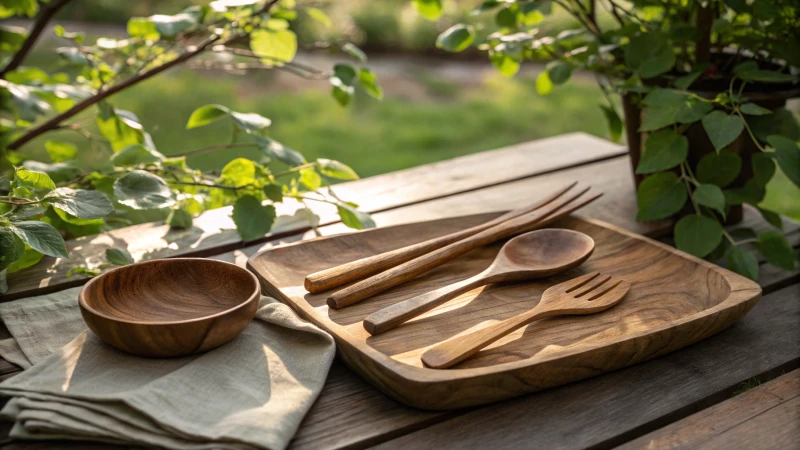
The Environmental Impact of Wooden Cutlery
I still remember the first time I switched from plastic to wooden cutlery. It felt like a small but significant step toward a more sustainable lifestyle. Wooden cutlery breaks down within months, unlike plastic that lingers for centuries. This means less landfill waste and a cleaner planet—a cause close to my heart.
Manufacturing wooden cutlery also consumes less energy than plastic, which translates to a lower carbon footprint. When I learned about this, it felt good to know that my choices were helping reduce greenhouse gas emissions.
Health and Safety Advantages
One of my biggest concerns with plastic was the chemicals. I often worried about what might be leaching into my food. But with wooden cutlery, I feel safer knowing that natural materials aren't introducing toxins to my meals. Plus, the antimicrobial properties of wood offer peace of mind, especially in settings like schools where hygiene is paramount.
Aesthetic and Branding Appeal
I’ve always loved the rustic charm of wooden utensils. They add a certain warmth and authenticity to any meal. For businesses like restaurants or cafes, this can enhance the dining experience and strengthen their eco-friendly image. And let's not forget the branding possibilities—customizing these utensils with a logo can make them unique and memorable.
| Aspect | Wooden Cutlery | Plastic Cutlery |
|---|---|---|
| Decomposition Time | Months | Centuries |
| Carbon Footprint | Low | High |
| Aesthetic Appeal | Natural and Customizable | Limited |
| Chemical Safety | Non-toxic | Potentially harmful chemicals |
Cost-Effectiveness Over Time
Initially, I hesitated because wooden cutlery seemed more expensive upfront. But over time, the savings add up. There are potential tax incentives for using eco-friendly products and lower waste management costs. Plus, aligning with consumer preferences for sustainability can boost brand loyalty and attract new customers.
Switching to wooden cutlery isn't just about doing what's trendy; it's about making a lasting impact. For me, it’s reassuring to know that such a simple change can contribute so much to a sustainable future.
Wooden cutlery decomposes in months, unlike plastic.True
Wooden cutlery naturally decomposes within months, reducing landfill waste.
Plastic cutlery has a lower carbon footprint than wood.False
Plastic production consumes more energy, increasing its carbon footprint.
How Do Environmental Impacts Compare Between Wood, Plastic, and Metal?
Deciding between wood, plastic, and metal isn't just about looks or durability—it's also about the environment. Each material tells its own story of sustainability, influencing our choices.
Wood generally outshines plastic and metal in sustainability because it's biodegradable and has a lower carbon footprint. But remember, the eco-friendliness of each material hinges on how it's sourced, produced, and disposed of.
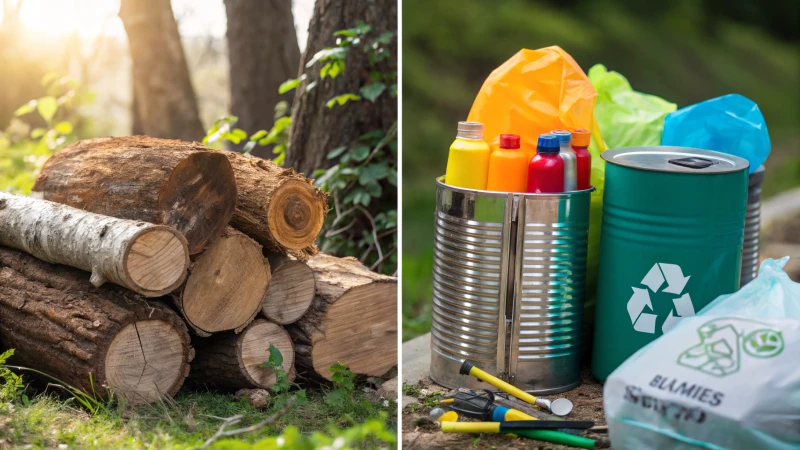
I remember the first time I truly started thinking about the environmental impact of materials. It was during a camping trip with some friends where everything we used had to be carried in and out. I was struck by the simplicity and beauty of wooden utensils compared to the plastic ones that seemed to linger forever without breaking down. That experience got me thinking: beyond just aesthetics and convenience, what are the real environmental impacts of materials like wood, plastic, and metal?
Evaluating Carbon Footprints
When I delved into this topic, I found that each material has a distinct carbon footprint, influenced by its lifecycle emissions.
- Wood often comes out on top because it can absorb carbon dioxide as it grows, reducing its overall footprint. However, irresponsible logging practices can erase these benefits quickly.
- On the other hand, Plastic has a high carbon footprint, mainly because it's made from fossil fuels. While biodegradable plastics1 are emerging, they're not yet mainstream enough to make a significant impact.
- Metal, despite its durability and recyclability, requires a lot of energy for production. Metals like aluminum become more eco-friendly if recycling is maximized, but getting to that point requires concerted efforts in waste management.
Waste Management and Decomposition
Wood naturally decomposes, which I saw firsthand when an old wooden spoon was accidentally left outside and turned back into the earth without a trace. This contrasts sharply with Plastic, which persists in the environment for centuries. Although recycling helps, widespread adoption is still a hurdle.
Meanwhile, Metal shines in waste management when properly recycled. Its infinite recyclability without quality loss can dramatically reduce environmental damage if recycling systems are efficient.
| Material | Decomposition | Recycling Potential |
|---|---|---|
| Wood | Natural | Limited |
| Plastic | Very Slow | Moderate |
| Metal | Slow | High |
Resource Extraction and Energy Consumption
The sustainability narrative continues with how these materials are extracted and produced.
- Wood is renewable if forests are managed responsibly.
- In contrast, Plastic relies on dwindling fossil fuels, posing long-term sustainability issues.
- Metal mining is notorious for its environmental toll unless balanced with effective recycling practices.
Understanding these dynamics isn't just academic; it informs real-world choices we make every day. Whether it's selecting materials for a new project or simply choosing what cutlery to use at a picnic, knowing the environmental stories behind wood, plastic, and metal can guide us toward more sustainable living.
Wood has the highest carbon footprint.False
Wood typically has the lowest carbon footprint due to carbon sequestration.
Plastic is biodegradable in landfills.False
Most plastics take hundreds of years to decompose, causing pollution.
Is Wooden Cutlery Durable Enough for Everyday Use?
Have you ever wondered if wooden cutlery can stand the test of time in our daily lives? Let's dive into its durability and discover whether it's a worthy addition to our eco-friendly routines.
Wooden cutlery can indeed be durable enough for everyday use, provided it's well-maintained. It holds up well to regular meals, though it's not as tough as metal. With proper care, like handwashing and occasional oiling, its longevity can be significantly enhanced.
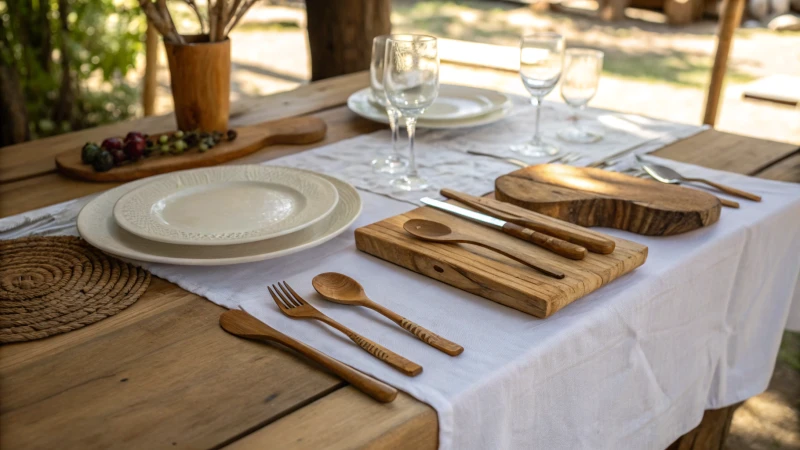
Understanding Wooden Cutlery Durability
I remember when I first switched to wooden cutlery—it felt like a small yet impactful step towards sustainability. Made from hardy woods like birch or bamboo, these utensils are designed to handle the rigors of everyday meals. Sure, they're not as indestructible as metal, but with their natural charm and strength, they rarely let me down at the dinner table.
| Material | Durability | Maintenance |
|---|---|---|
| Metal | High | Low |
| Plastic | Medium | Low |
| Wood | Medium | Medium |
Maintenance Tips for Longevity
Just like a favorite pair of shoes, wooden cutlery benefits from a bit of TLC. I learned early on that handwashing them immediately after use is crucial. It prevents water from seeping in and causing damage. Every now and then, I give them a rub with food-grade mineral oil to keep them looking fresh and less prone to cracks or warping.
Comparing Wooden Cutlery with Alternatives
When I compared wooden cutlery with its plastic and metal counterparts, the sustainable edge was hard to ignore. Yes, they require a touch more care, but this minor inconvenience is easily outweighed by their eco-friendly nature. While metal might boast superior durability, it lacks the environmental benefits that wooden options bring to the table.
Sustainability benefits2 often outweigh the minor inconvenience of additional maintenance when compared to plastic. In contrast, metal cutlery provides superior durability but lacks the eco-friendly appeal of wood.
Environmental Impact and Usage
Embracing wooden cutlery has been part of my journey toward living more sustainably. It's biodegradable and sourced from renewable resources—a win-win for both my conscience and the planet. Though it doesn't match metal in sheer toughness, its positive environmental impact makes it an appealing choice for day-to-day use. Plus, making this switch feels like a meaningful contribution towards reducing reliance on single-use plastics.
For anyone contemplating this change, understanding the cost comparison3 with other options is essential. Although initial costs might be higher than plastic, the long-term advantages—such as environmental savings and potential bulk purchasing benefits—often make it a savvy investment.
Wooden cutlery is as durable as metal utensils.False
Wooden cutlery is durable but not as resilient as metal utensils.
Handwashing wooden cutlery extends its lifespan.True
Handwashing prevents water absorption, reducing warping or cracking.
How Can Wooden Cutlery Elevate Your Brand’s Image?
I remember the first time I held a piece of wooden cutlery at a local café, and it just felt right—like I was part of something bigger, something greener.
Wooden cutlery can elevate your brand's image by aligning it with eco-friendly values, enhancing aesthetic appeal, and showcasing a commitment to sustainability. These attributes resonate with environmentally conscious consumers, potentially boosting brand loyalty.
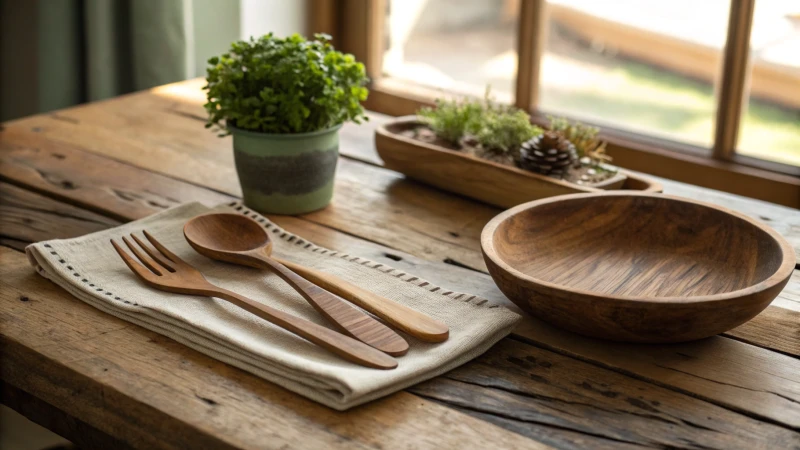
The Aesthetic Appeal of Wooden Cutlery
I’ve always believed that dining is as much about the experience as it is about the food. The first time I saw a logo engraved on a wooden fork, it struck me how something so simple could feel so luxurious. Wooden cutlery brings a rustic charm that's hard to replicate with plastic or metal. This charm transforms meals into memorable experiences, especially in places like high-end restaurants or cozy eco-friendly cafes. When you add customizable branding options4, such as engraving logos on the handles, it supports a cohesive brand image that truly resonates with customers.
Environmental Impact and Consumer Perception
Switching to wooden cutlery isn’t just about style; it's a statement of values. I’ve seen firsthand how choosing biodegradable and renewable materials over plastic alternatives can significantly boost consumer perception. For brands targeting eco-conscious demographics, this choice loudly signals an alignment with their values. It's like saying, "We're in this together," and studies back this up—consumers are increasingly willing to spend more on products they perceive as environmentally friendly.
| Material | Cost | Environmental Impact | Customization Potential |
|---|---|---|---|
| Wooden | Moderate | Biodegradable, Renewable | High |
| Plastic | Low | Non-biodegradable | Limited |
| Metal | High | Recyclable | Moderate |
The Cost-Benefit Analysis
While there’s no denying wooden cutlery is pricier than plastic, I’ve come to realize that the long-term benefits often outweigh these costs. Customers today lean towards brands that echo their environmental responsibility, and this shift can be a game-changer in competitive markets. Investing in sustainable products could enhance customer loyalty and bolster your brand reputation.
Practical Considerations and Limitations
However, wooden cutlery isn't without its quirks—think of it as having character. It might not be as durable as metal for certain uses, so it’s crucial to weigh your specific needs and customer expectations. Learning from case studies5 of businesses that have successfully integrated wooden cutlery into their operations can provide valuable insights into overcoming these challenges.
Understanding these dynamics allows brands to make informed decisions about incorporating wooden cutlery into their offerings, thereby enhancing their image while meeting the growing consumer demand for sustainability.
Wooden cutlery can enhance a brand's eco-friendly image.True
Wooden cutlery is biodegradable and reflects sustainability, appealing to eco-conscious consumers.
Plastic cutlery offers better customization options than wooden.False
Wooden cutlery has higher customization potential, allowing for engraved logos and designs.
Conclusion
Disposable wooden cutlery offers environmental benefits and aesthetic appeal, making it a worthwhile investment for eco-conscious businesses despite higher initial costs compared to plastic alternatives.
-
Discover recent innovations that aim to reduce the environmental impact of plastics by enhancing their biodegradability. ↩
-
Learn how wooden cutlery's sustainable nature helps reduce environmental impact compared to plastic alternatives. ↩
-
Understand the cost implications when choosing between wooden and plastic cutlery for everyday use. ↩
-
Explore customization options to reinforce brand identity and appeal to customers with personalized, eco-friendly utensils. ↩
-
Learn from successful examples of how businesses have used wooden cutlery to enhance their image and sustainability efforts. ↩

